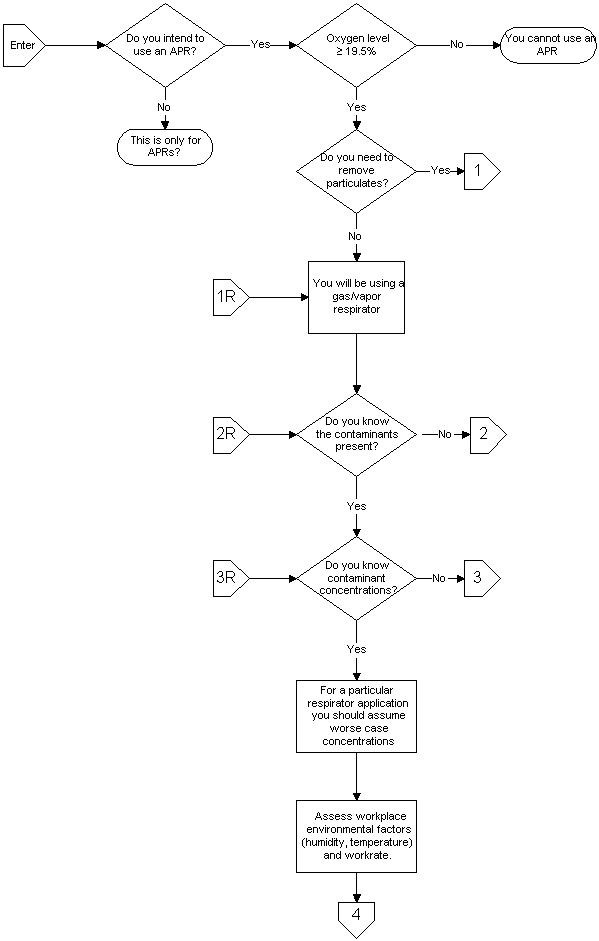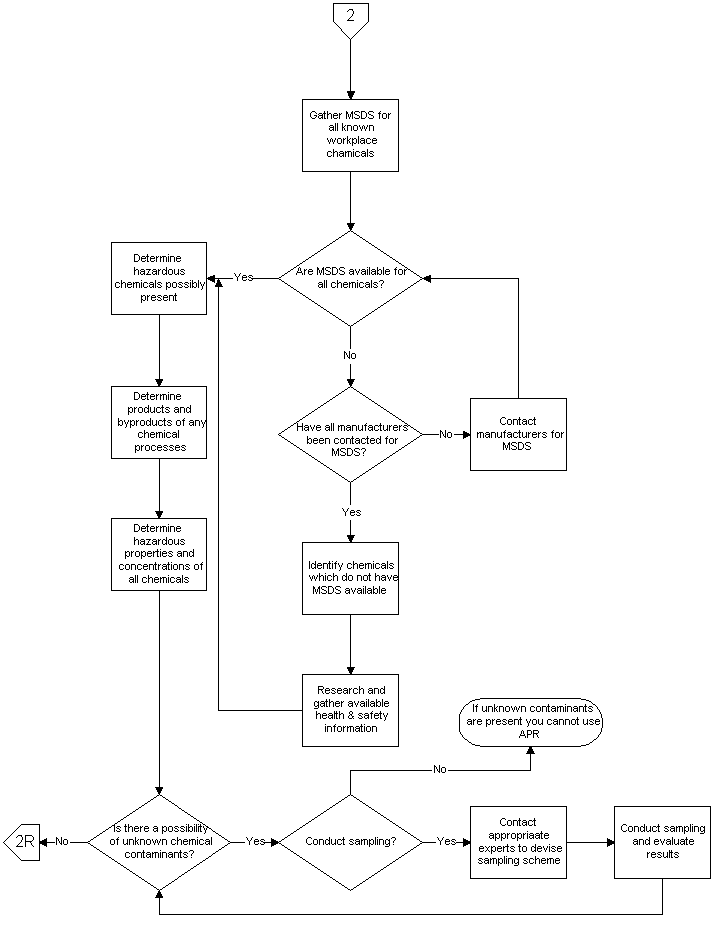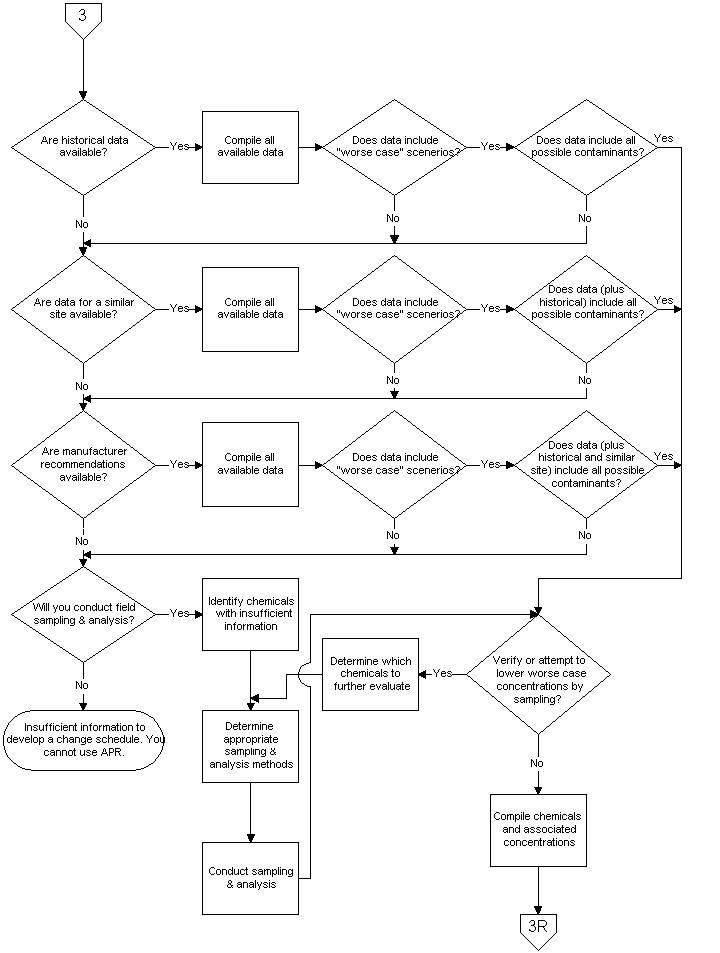Respiratory Protection eTool
Respirator Change Schedules » Decision Logic Flowcharts
The following flowcharts present a logic diagram for the development of a respirator cartridge change schedule. The diagram starts and then continues to various other sections. To jump to the next page, choose the link to the correct connector.
If you want to print the diagrams, you may have a problem with Flowcharts 2, 3, and 4 printing wider than a standard page. You can probably overcome this problem by: setting the margins in page setup to minimum values (0.25 inch or less), or by printing in landscape mode.
Text Version
- Enter
- Do you intend to use an APR?
- Yes - Go to "Oxygen level is ≥ 19.5%"
- No - This is only for APRs - END
- Oxygen level is ≥ 19.5%
- Yes - You cannot use an APR - END
- No - Go to "Do you need to remove particulates?"
- Do you need to remove particulates?
- Yes - Go to flowchart 1
- No - Go to "You will be using a gas/vapor respirator"
- 1R You will be using a gas/vapor respirator?
- 2R Do you know the contaminants present?
- Yes - Go to "Do you know contaminant concentrations?"
- No - Go to flowchart 2
- 3R Do you know contaminant concentrations?
- Yes - Go to "For a particular respirator you should assume worse case concentrations"
- No - Go to flowchart 3
- For a particular respirator you should assume worse case concentrations.
- Assess workplace environmental factors (humidity, temperature) and workrate.
- Go to flowchart 4
- Do you intend to use an APR?

Text Version
- 1
- Is the median mass aerodynamic diameter ≥ to 2 µm.
- Yes - Use any NIOSH certified particulate filter cartridge - Go to "Enter information into respiratory protection program"
- No - Go to "Use a HEPA filter (35 CFR 11) or any NIOSH (42 CFR 84) filter"
- Unknown - Assume median mass < 2 µm - Go to "Use a HEPA filter (35 CFR 11) or any NIOSH (42 CFR 84) filter"
- Use a HEPA filter (35 CFR 11) or any NIOSH (42 CFR 84) filter.
- Enter information into respiratory protection program.
- Are gaseous contaminants present?
- Yes - 1R Go to main page
- No - No further action.
- Is the median mass aerodynamic diameter ≥ to 2 µm.

Text Version
- 2
- Gather MSDS for all known workplace chemicals.
- Are MSDS available for all chemicals?
- Yes - Go to "Determine hazardous chemicals possibly present"
- No - Go to "Have all manufacturers been contacted for MSDS?"
- Have all manufacturers been contacted for MSDS?
- Yes - Go to "Identify chemicals which do not have MSDS available"
- No - Contact manufacturers for MSDS - Go to "Are MSDS available for all chemicals?"
- Identify chemicals which do not have MSDS available.
- Research and gather available health & safety information.
- Determine hazardous chemicals possibly present.
- Determine products and byproducts of any chemical process.
- Determine hazardous properties of concentrations of all chemicals.
- Is there a possibility of unknown chemical contaminants?
- Yes - Go to "Conduct sampling?"
- No - 2R - Go to main page
- Conduct sampling?
- Yes - Go to "Contact appropriate experts to devise sampling scheme"
- No - If unknown contaminants are present you cannot use APR.
- Contact appropriate experts to devise sampling scheme.
- Conduct Sampling and evaluate results - Go to "Is there a possibility of unknown chemical contaminants?"

Text Version
- 3
- Are historical data available?
- Yes - Compile all available data - Go to "(1) Does data include 'worse case scenarios?'"
- No - Go to "Are data for a similar site available?"
- (1) Does data include "worse case scenarios?"
- Yes - Go to "Does data include all possible contaminants?"
- No - Go to "Are data for a similar site available?"
- Does data include all possible contaminants?
- Yes - Go to "Verify or attempt to lower worse case concentrations by sampling?"
- No - Go to "Are data for a similar site available?"
- Are data for a similar site available?
- Yes - Compile all available data - Go to "(2) Does data include 'worse case scenarios?'"
- No - Go to "Are manufacturer recommendations available?"
- (2) Does data include "worse case scenarios?"
- Yes - Go to "Does data (plus historical) include all possible contaminants?"
- No - Go to "Are manufacturer recommendations available?"
- Does data (plus historical) include all possible contaminants?
- Yes - Go to "Verify or attempt to lower worse case concentrations by sampling?"
- No - Go to "Are manufacturer recommendations available?"
- Are manufacturer recommendations available?
- Yes - Compile all available data - Go to "(3) Does data include 'worse case scenarios?'"
- No - Go to "Will you conduct field sampling & analysis?"
- (3) Does data include "worse case scenarios?"
- Yes - Go to "Does data (plus historical and similar site) include all possible contaminants?"
- No - Go to "Will you conduct field sampling & analysis?"
- Does data (plus historical and similar site) include all possible contaminants?
- Yes - Go to "Verify or attempt to lower worse case concentrations by sampling?"
- No - Go to "Will you conduct field sampling & analysis?"
- Will you conduct field sampling & analysis?
- Yes - Identify chemicals with insufficient information - Go to "Determine appropriate sampling & analysis methods"
- No - Insufficient information to develop a change schedule. You cannot use APR.
- Determine appropriate sampling & analysis methods.
- Conduct sampling & analysis.
- Verify or attempt to lower concentrations by sampling?
- Yes - Determine which chemicals to further evaluate - Go to "Determine appropriate sampling & analysis methods"
- No - Compile chemicals and associated concentrations - 3R - Go to main page
- Are historical data available?

Text Version
- 4 The results of the following decisions can be combined based on contaminant/cartridge combinations.
- Does the cartridge have an ESLI for all contaminants?
- Yes - A change-out schedule is not required.
- No - Go to "Is manufacturer recommendation available for cartridge type?"
- Is manufacturer recommendation available for cartridge type?
- Yes - Go to "Using manufacturer's information and your work environment, develop service life for each respirator user".
- No - Go to "Is breakthrough data available for contaminants?"
- Is breakthrough data available for contaminant?
- Yes - 5 Go to flowchart 5
- No - Go to "Will you perform testing to obtain needed data?" - 5R
- Will you perform testing to obtain needed data?
- Yes - 6 Go to flowchart 6
- No - Insufficient information to develop a change-out schedule. You cannot use an APR.
- Using manufacturer's information and your work environment, develop service life for each respirator user.
- 7 - Document respirator cartridge change-out schedule.
- Identify all gas/vapor respirator type, manufacturers, and cartridges to be included.
- Identify each job classification which will be using a respirator.
- Identify all environmental and work factors (temperature, humidity, work rate, expected time used, etc.) for each job class.
- For each job class, identify all contaminants and worse case concentration.
- For each combination of the above items, document the maximum time between cartridge changes.
- Unless substantial information supports a decision otherwise, require cartridges to be changed at the end of each work shift.
- Prepare a written document describing all factors and supportive data used to develop the change-out schedule.
- Train respirator users in the application of the change-out schedule and ensure they are aware of the availability of the change-out schedule documentation.
- Enter change-out schedule information into respiratory protection program.
- Review change-out schedule annually or whenever a change occurs in respirator manufacture or usage.
- Does the cartridge have an ESLI for all contaminants?

Text Version
- 5
- For each contaminant present:
- Were data obtained using the same sorbent material?
- Yes - Go to "Were data obtained at similar or higher humidity?"
- No - 5R Go to flowchart 4
- Were data obtained at similar or higher humidity?
- Yes - Go to "Were temperature and work rate similar?"
- No - 5R Go to flowchart 4
- Were temperature and work rate similar?
- Yes - Go to "Are there multiple contaminants present?"
- No - 5R Go to flowchart 4
- Are there multiple contaminants present?
- Yes - Go to "Were data obtained at similar or higher concentrations?"
- No - Calculate the sum of all contaminant concentrations - Go to "Were data obtained at similar or higher concentrations?"
- Were data obtained at similar or higher concentrations?
- Yes - Go to "From breakthrough data obtain projected service life for contaminant based on concentration (total) and humidity"
- No - 5R Go to flowchart 4
- From breakthrough data obtain projected service life for contaminant based on concentration (total) and humidity.
- Adjust service life for number of cartridges and work rate.
- Multiply service life by safety factor.
- Are there additional contaminants to process?
- Yes - Go to "For each contaminant present"
- No - Use the minimum service life calculated as the respirator service life - 7 Go to flowchart 4

Text Version
- 6
- Are contaminants likely candidates for testing?
- Yes - Go to "Perform laboratory tests?"
- No - A change-out schedule is not appropriate for these contaminants. You cannot use APR.
- Unknown - Go to "Do contaminants meet 'Rule of thumb?'"
- Do contaminants meet "Rule of thumb?"
- Yes - Go to "Attempt mathematical prediction?"
- No - A change-out schedule is not appropriate for these contaminants. You cannot use APR.
- Attempt mathematical prediction?
- Yes - Go to "Perform model to estimate service life"
- No - Go to "Are contaminants likely candidates for testing?"
- Perform model to estimate service life - Go to "Are contaminants likely candidates for testing?"
- Perform laboratory tests?
- Yes
- Laboratory testing protocols.
- Field testing protocols.
- 7 Go to flowchart 4
- Are contaminants likely candidates for testing?


